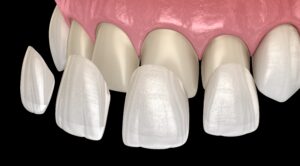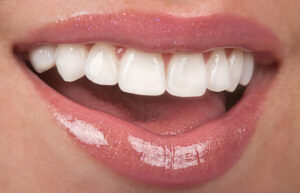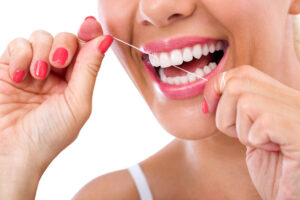Are Porcelain Veneers Permanent?
Porcelain veneers are a popular cosmetic dentistry treatment that enable someone to re-create his or her smile. As with any type of dental procedure, there are many factors affecting the long-term success of porcelain veneers. In this article, we will explain all you need to know if you are considering a smile improvement with porcelain veneers.
What are Porcelain Veneers?
 A veneer is a covering or laminate. In dentistry, a veneer covers the visible surface of the tooth to change the appearance of it. We use a variety of dental materials to make cosmetic changes, and porcelain is the most common.
A veneer is a covering or laminate. In dentistry, a veneer covers the visible surface of the tooth to change the appearance of it. We use a variety of dental materials to make cosmetic changes, and porcelain is the most common.
Porcelain veneers can be relatively thin, like a contact lens, or thicker to hide underlying defects in the teeth. We can make them bright, opaque white in color, or we can add characterization to create a natural appearance. There is a lot of variety possible with porcelain veneers.
When it comes to improving a smile, you can choose to cover one or ten teeth. Your dentist can help you decide which teeth need covering to give you the smile you desire.
How do Porcelain Veneers Attach to the Teeth?
Your dentist attaches porcelain veneers to the teeth in a similar manner that an orthodontist attaches braces. We use a composite resin that bonds to both the tooth structure and the porcelain.
Your dentist will prepare the teeth for the porcelain veneers at the first visit. This involves removing enough enamel to create space for the replacement with porcelain. Your dentist will capture a perfect impression of these preparations with a three-dimensional digital scan. We send the impression to our extremely talented cosmetic lab technician and cover the prepared teeth with temporary veneers.
We use a different attachment process for the temporary veneers because we must be able to remove them to place the porcelain veneers. After trying in the porcelain veneers and verifying their appearance, your dentist attaches them to the teeth with a final cementation procedure.
What Problems Can Require Removal and Replacement of Porcelain Veneers?
While many people call both porcelain veneers and the final cementation process “permanent”, we dislike that term. It could give people the wrong impression, that veneers never require replacement. In fact, they can require replacement for a variety of conditions, which we’ll explain here.
Debonding
It is possible for an entire veneer to detach from the underlying tooth surface. We call this “debonding”. This can occur as a result of a problem with the bonding process itself (when the veneer was originally attached to the tooth) or as the result of heavy forces that break the attachment over time.
If the cause is a problem during the original bonding process, the debonding will occur relatively soon after the veneer’s placement. If a veneer detaches years after being placed, we can assume that there are some heavy forces applied to the tooth. This is often the case when someone clenches or grinds his or her teeth during sleep. The forces of nighttime clenching or grinding slowly break the bond of a veneer causing it to fall off.
Typically, we can simply re-bond a debonded veneer in a relatively quick and painless procedure.
Chipping or Breaking
Porcelain is a beautiful tooth replacement material with a translucence and gloss that mimics natural teeth very well. It is also quite brittle. Porcelain can chip or break under heavy forces. We often see chipped and broken veneers in our patients with heavy clenching or grinding habits. Chips and breaks are also common among veneer patients who use their teeth in ways they should not (i.e. holding hair pins, opening packages, tearing fishing line).
A chipped or broken porcelain veneer cannot be repaired. We must remove it and replace it.
New Decay
Decay is another problem requiring replacement of the veneer. The veneer covers only the visible surfaces of the teeth. It is possible to develop new cavities at the edges of a veneer, especially between the teeth.
Because cavities slowly grow over time, we must stop the decay by removing it. In some cases, it may be possible to repair a small cavity at the edge of a veneer with a tooth-colored filling, but if extensive decay develops, we must replace the entire veneer.
How Can I Give my Porcelain Veneers the Best Long-Term Success?
 In order to help your beautiful porcelain veneers last for decades, you must take preventive measures to protect them and their underlying teeth. Here are the most important steps you can take to give your veneers a long lifespan.
In order to help your beautiful porcelain veneers last for decades, you must take preventive measures to protect them and their underlying teeth. Here are the most important steps you can take to give your veneers a long lifespan.
Protect Against Heavy Forces
Both debonding and chipped, broken porcelain are common in patients who clench and/or grind their teeth. We must protect against those forces if we want the veneers to last for many years. The most important thing you can do is to wear a protective mouthguard over the veneers every night during sleep.
Dr. Ann will assess your specific risk for nighttime habits and recommend a custom-fitted nightguard when appropriate. You may get a little protection from an over-the-counter mouthpiece, but for lasting protection, you should invest in a professional nightguard. The cost of the nightguard is less than replacing a single veneer!
If you have any habits of using your teeth outside of their normal functions (we call these parafunctional habits), you must work diligently to stop these habits. Never use your teeth as tools. They are meant for smiling, speaking, and chewing only.
Fight Cavities
Fighting decay is an essential part of maintaining great oral health and preserving the integrity of all existing dental work. There are several important ways to prevent new cavities.
 Maintain a great oral hygiene routine at home. Your daily brushing and flossing is necessary to remove dental plaque from the teeth. Plaque is the home of the bacteria that cause cavities. When you remove it consistently and effectively every day, your risk for cavities decreases greatly.
Maintain a great oral hygiene routine at home. Your daily brushing and flossing is necessary to remove dental plaque from the teeth. Plaque is the home of the bacteria that cause cavities. When you remove it consistently and effectively every day, your risk for cavities decreases greatly.- Maintain consistent professional teeth cleanings and follow-up visits with the dentist. Teeth cleanings remove any bacterial buildup that you may miss during your home care. Your dentist evaluates the health of your mouth, including your existing dental work and makes recommendations for prevention and preservation. Your dentist can spot early warning signs of dental disease and help you stop it before it starts.
- Avoid high sugar snacks and drinks. Most people know that sugar can cause cavities. “Sugar” also includes simple carbohydrates. It is important to limit the amount of simple carbohydrates you ingest because that also limits the amount of fuel you provide the cavity-causing bacteria living in plaque. Without sugar, they cannot cause cavities.
- Fight dry mouth. A dry mouth is not a healthy mouth. Saliva is one of our best cavity fighters, and those suffering from dry mouth have a high risk for developing new cavities. You must work to moisturize and neutralize your mouth by drinking plenty of water, using salivary stimulants, and adding saliva replacements as necessary. If you notice that your mouth feels dry, talk to your dentist. We can recommend specific products to help you manage it and reduce your risk for cavities.
More Questions about Porcelain Veneers?
Call Designer Smiles today to schedule a consultation with Dr. Ann. She has created hundreds of beautiful smiles with porcelain veneers, and she loves helping her patients maintain them for decades. She can answer any specific questions you have about your own veneers and assess any risk factors that you exhibit.
